
 Environmental Protection311
Environmental Protection311 Search all NYC.gov websites
Search all NYC.gov websites
Invasive Species
Invasive species are non-native and harmful plants, animals, and microorganisms that exist in an environment. In our case, they threaten drinking water quality and recreation opportunities in our watershed. To protect the natural ecosystems of the watershed, we implement a proactive, comprehensive approach that anticipates and addresses invasive species threats and impacts as early as possible. Boaters, anglers, hunters and hikers can help us protect our watershed and recreation opportunities by reporting sightings of some of the most harmful species.
Invasive Species Report Form
Infestations of invasive species are often first discovered by members of the public. Reporting your encounter helps us in the ongoing effort to protect our ecosystem. If you believe you have come across an invasive species in our watershed, please Submit an Invasive Species Report Form and attach any images you have of your encounter.
Prevent the Spread of Aquatic Invasive Species
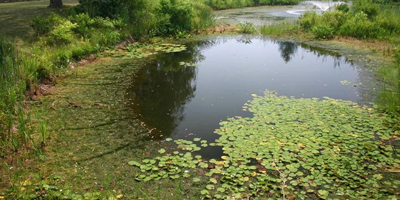
Photo Credit: Leslie J. Mehrhoff, University of Connecticut, Bugwood.org
Hydrilla (Hydrilla verticallata)
Hydrilla is an aquatic plant is found in lakes, ponds, and waterways throughout New York. It can quickly form dense mats that decrease the oxygen available for fish and promote harmful algae growth. Learn more about Hydrilla Managment in the watershed.
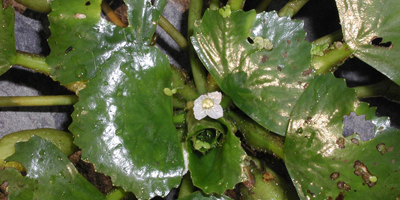
Photo Credit: Leslie J. Mehrhoff, University of Connecticut, Bugwood.org
Water Chestnut (Trapa natans)
The Water Chestnut is a floating aquatic plant that can cover large areas, keeping other plants from growing and changing temperatures and oxygen available for fish. View the DEC Water Chestnut Factsheet.
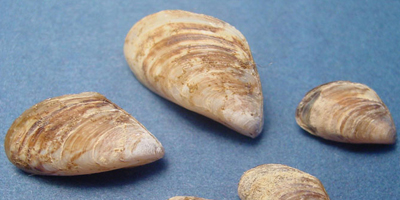
Amy Benson, U.S. Geological Survey, Bugwood.org
Zebra & Quagga Mussels (Dreissena polymorpha and bugensis)
The zebra mussels, along with their close relative, the quagga mussel, can clog intake pipes and change an aquatic system rapidly by selectively filtering out what they like. View the United States Geological Survey Zebra Mussel Factsheet.
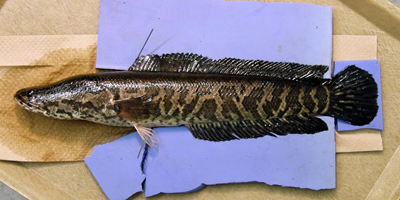
Photo Credit: U.S. Geological Survey, U.S. Geological Survey, Bugwood.org
Northern Snakehead Fish (Channa argus)
The Northern Snakehead is a voracious predator that can consume large numbers of fish, quickly becoming the dominant species in a waterbody. View the DEC Northern Snakehead Factsheet.
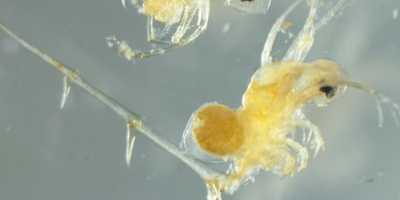
Photo Credit: Gary Montz, 144, Bugwood.org
Spiny Waterflea (Bythotrephes longimanus)
The Spiny Waterflea is a small crustacean that can be transported in fishing gear. It will not only foul up your fishing pole guides when you reel in your line, it also gets stuck in the throats of young sport fish, causing them to choke or feel full so they can’t feed and are less likely to survive. View the DEC Spiny Waterflea Factsheet.
The New York State Department of Environmental Conservation (DEC) maintains a list of Common Aquatic Invasive Species in New York State. This list includes all of the invasive species mentioned in this section, as well as cleaning strategies if you encounter them. While enjoying the fishing and boating recreation opportunities that exist in New York City Watershed, please keep an eye out for these invasive plants and animals and report them if you think you’ve seen them. Submit an Invasive Species Report Form.
A few simple steps are all that are needed to help prevent the introduction of a new aquatic invasive species in the New York City Watershed:
- Clean your gear (anything that comes in contact with the water) or let it dry thoroughly before using it in another body of water. Learn more about the Disinfection Techniques for Fishing and Boating Equipment.
- Always use certified or locally collected bait and dispose of unused bait in the trash, not on land or in a reservoir. Learn more about Baitfish Regulations.
For more information about fishing and boating opportunities in the watershed, please visit Recreation.
Prevent the Spread of Field & Forest Invasive Species
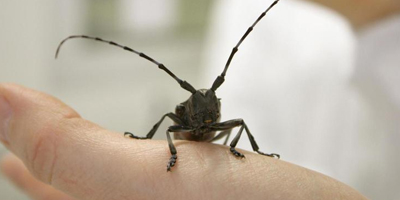
Photo Credit: Karen Snover-Clift, Cornell University, Bugwood.org
Asian Longhorned Beetle (Anoplophora glabripennis)
The Asian longhorned beetle has an appetite for maple trees and a number of other of hardwood trees. This tree-boring insect has the ability to decimate watershed forests if it found its way upstate. View the DEC Asian Longhorned Beetle Factsheet.
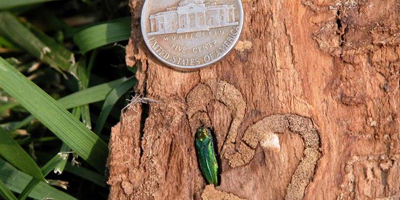
Photo Credit: Eric R. Day, Virginia Polytechnic Institute and State University, Bugwood.org
Emerald Ash Borer (Agrilus planipennis)
The Emerald Ash Borer is a small metallic boring beetle that spends most of its adult life flying high in the canopy of ash trees. As a larva, it hides underneath the bark and can be very hard to detect. View the DEC Emerald Ash Borer Factsheet.

Terry English, USDA APHIS PPQ, Bugwood.org
Giant Hogweed (Heracleum mantegazzianum)
Giant hogweed is a tall, flowering plant that can cause serious skin burns. Do not touch it! View the DEC Giant Hogwood Factsheet.

Photo Credit: The Nature Conservancy, The Nature Conservancy, Bugwood.org
Eurasian Boar (Sus scrofa)
Eurasian boars are dangerous to humans and pets because of their aggressive behavior as well as the diseases and parasites that they carry. View the Eurasian Boar Factsheet.
The New York State Department of Environmental Conservation maintains a list of Terrestrial Invasive Species in New York State. This list includes all of the invasive species mentioned in this section, as well as cleaning strategies if you encounter them. While enjoying the hiking and hunting recreation opportunities that exist in New York City Watershed, please keep an eye out for these invasive plants and animals and report them if you think you’ve seen them. Submit an Invasive Species Report Form.
A few simple steps are all that are needed to help prevent the introduction of new invasive species in the watershed:
- Come clean. Inspect your boots and clothing for mud or seeds before visiting a new spot.
- Leave clean. Clean mud and seeds off your boots and clothing again before you leave.
- While enjoying the recreation opportunities that exist in the fields and forests of the watershed, please keep an eye out for these plants and animals and report them if you think you’ve seen them.
For more information about hiking and hunting opportunities in the watershed, please visit Recreation.


